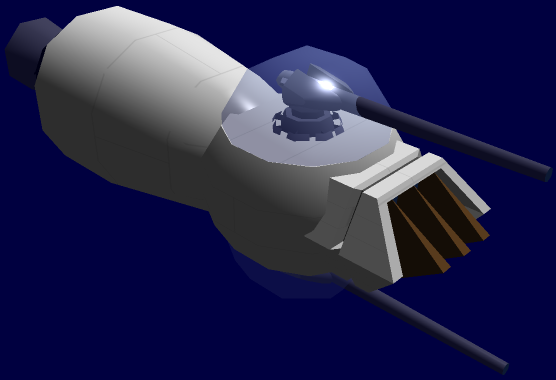Sidebar
Aether-heated Jet Engine
 Pictured: PT-X1-1A Tsubame's Aether-heated Jet Engine
Two Light Point Defense Turrets are also shown.
Pictured: PT-X1-1A Tsubame's Aether-heated Jet Engine
Two Light Point Defense Turrets are also shown.
Developed in YE 32 by Project THOUGHT with Kage Yaichiro's design and input, the Aether-heated Jet Engine is a cheap and easy to produce atmospheric propulsion system with limitless fuel. It is intended not only for use in atmospheric and submersible craft, but as an alternate operation mode for future Turbo Aether Plasma Drive Drives which would allow use in atmosphere or even underwater. It can be used in conjunction with a Combined Field System as well as with Project THOUGHT Frictionless Hybrid Joints or Project THOUGHT Simplified Joints for thrust vectoring, and can take many physical forms.
History
While developing concepts for the Tsubame Prototype Fighter, it was realized that a very simple jet engine with limitless fuel could be utilized for within a planet's atmosphere or oceans simply by moving heat away from an Aether Generator and using it to expand or combust the medium being traveled in. Such a simple method may not have had immediate military applications at first glance, but it was realized that combining the technology with existing Turbo Aether Plasma Drive Drive technology may make military-grade engines more useful with minimum cost. With both civilian and military applications abound for the simple and easily modified concept, the simple engines were approved for field testing on the prototype fighter.
Basic Description
The Aether-heated Jet Engine is extremely simple, and utilizes an Aether Generator to spin a high speed intake fan and ignite air(or expand water) with a heating system behind the intake which shunts heat from the Aether Generator to the engine. It is noteworthy in that it lacks as many moving parts as a turbofan or a turbojet. Of course, this requires that the engine usually be constructed with Durandium Alloy or higher grade metals due to the high heat used, but allows for underwater operation as well since no chemical accelerant is utilized in the system.
The speed of the intake and the temperature of the heating element that expands the air or water and forces it out the back of the jet is typically adjustable depending on temperature and the density of the medium being traveled through, as well as the desired acceleration. This is often handled by an on-board computer or a cockpit-controlled computer system if installed on a craft. Many models are limited by the physical fan intake, and typically have a maximum airspeed in the realm of 3,581 kph/2,225 mph (roughly Mach 3 at sea level) due to this. Some higher end military variants utilize rotating forcefields to simulate the intake fan. In these cases the intakes can be deactivated or even modified to tilt inward and aid in compression, and the jets switch over to a form of operation comparable to a Ramjet; attaining an estimated airspeed of 7,163 kph/4,450 mph (roughly Mach 6 at sea level). Depending on the actual construction of the engine, this can be increased further, but enters the realm of specialized scramjet engines that use more exotic materials than Durandium. Note that these speeds are considerably slower underwater but still function.
Variants that are integrated into spacecraft or are part of Turbo Aether Plasma Drive Drives sometimes have intakes with retractable armor, so as to conceal and provide protection to the drive when the intakes are not in use.
Page Tools
Terms of Service - Privacy Policy
